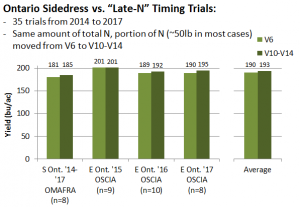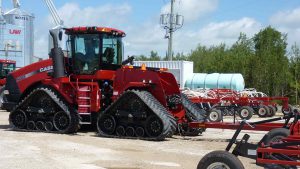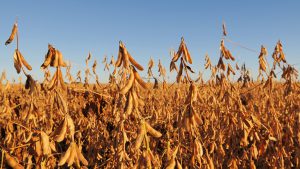Cropside: Delayed N applications

WITH GREATER PREVALENCE of high clearance applicators and technology for applying nitrogen (N) beyond the traditional side-dress stage, there are lots of questions about the advantages of late N applications. In many cases, these applications are made in later vegetative stages but well prior to tassel emergence (ie. V10-V14) after a reasonable amount of N had been applied around planting.
WHY DELAY NITROGEN APPLICATIONS?
There are a couple concepts floated around delayed N applications. One is that delaying a large portion of N to a later stage better aligns N supply with crop demand, limiting potential for denitrification or leaching losses. Another is that “spoon-feeding” the corn crop with multiple applications helps maximize yields by ensuring the plant is growing in an environment where N is never limiting.
WHAT IS THE NATURE OF YIELD RESPONSE FOR MOVING A PORTION OF NITROGEN TO LATER APPLICATION STAGES?
A number of trials have been conducted by Ontario Soil and Crop, Grain Farmers of Ontario, and OMAFRA projects. In these trials, all treatments receive the same total amount of N but a portion is moved across different timings, from preplant to sidedress to late vegetative stages (Figure 1) or from sidedress to late vegetative stages (Figure 2). Depending on the project, N rates were either the grower’s rate or a very conservative N rate to increase the probability that differences in N efficiency would be reflected in final yields.


On average, there were slight yield responses for delaying a portion of N to later stages. At trials where a portion of N was moved from preplant to sidedress to later vegetative stages, yields were 174, 179, and 182 bu/ac respectively (Figure 1). At trials where a portion of N was moved from sidedress to later vegetative stages, yields were 190 and 193 bu/ac respectively (Figure 2). Yield responses appeared to be dependent on environment, as many locations had no difference in yield for the various application timings, while some had large responses for delaying N. No yield penalties were observed for delaying a portion of N to later stages in these trials.
It appears that if sufficient N remains in the system, there is no response to delayed applications, suggesting the “spoon-feeding” concept may not deliver extra yield. However, in environments with high N losses, it appears there can be a response to strategies that better align N applications with crop uptake. Whether you observe responses to delayed N on your farm may depend on your existing N rates, your risks for N loss, your current N application timings, and your use of N credits for manure or red clover.
Beyond yield, another benefit of delayed N applications may be the ability to adjust rates based on the season (precipitation, expected yield etc.). This is an emerging area in corn N research. •



























